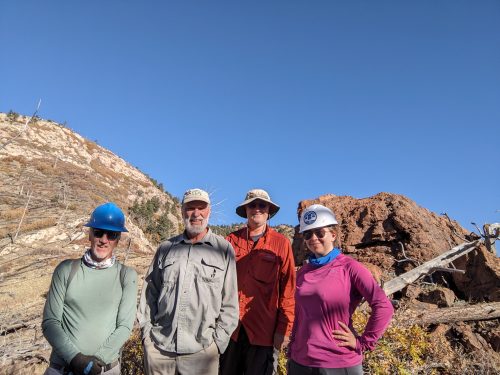Four NMVFO volunteers met at New Canyon Campground in the Manzanos and hiked up to Osha Peak, sawing and lopping on a beautiful fall day.





Trail maintenance season is almost over!

Sagebrush personal hiking blog
Four NMVFO volunteers met at New Canyon Campground in the Manzanos and hiked up to Osha Peak, sawing and lopping on a beautiful fall day.





Trail maintenance season is almost over!

Landing page for the entire series of posts on graph theory and trails.
It all started with a question:
What is the longest continuous route on existing trails in the Gila National Forest, that does not repeat any segment (but intersections are OK)?
And what is the longest continuous loop?
Can the result be mapped and documented as a Long Trail to share with hikers?Sagebrush
Graph Theory is a branch of mathematics that can help us analyze a trail network. A graph has nodes (or points or vertices) that are connected by edges, and can be represented visually:

Long distance hikers, especially old-school hikers before hiking apps, have been accustomed to rely upon “databooks“, a brief text summary of the important intersections, water sources, features, and distances of a long hike. Here is a portion of a page from the Appalachian Trail 1987 databook, a slim pocket-size saddle-stapled booklet.

And this is an image from a portion of the databook for the Northern New Mexico Loop (by Blisterfree, the creator of the Grand Enchantment Trail).

Not all backpackers use a databook during their hike, even pre-app, but it is still useful for planning prior to the trip. Some hikers do find an advantage in reading a text summary on trail, rather than squinting at a topo map representation on their smartphone screen. Hike your own hike; your mileage may vary; use tools and do not let them use you.
In our previous post, we were able to find a long loop route in the Gila National Forest (that does not repeat any segment), in the form of a numeric list of nodes. Our graph imported via OSMnx from OpenStreetMap includes extra information as node attributes and edge attributes, that we can extract in a Pythony way to make our own databook of sorts. Here is an example of the text information in one edge of our graph.
{'osmid': 243511168, 'ref': '165', 'name': 'Pine Flat Trail #165', 'highway': 'path', 'oneway': False, 'reversed': [False, True], 'length': 4374.8279999999995, 'from': [2509057410, 2509594627, 2509057291, 2509594252, 2509057424, 2509594385, 2509594643, 2509594263, 2509594657, 2509594529, 2509057314, 2509594279, 2509594664, 2509594284, 2509594543, 2509594673, 2509594294, 2509057334, 2509594680, 2509594556, 2509594176, 2509594306, 2509594691, 2509594435, 2509057350, 2509594568,
<truncated>From that information we can generate a summary from our Euler graph.
MILE ELEVATION TRAIL INTERSECTION
...
105.0 6509 Hells Hole Trail #268 West Fork Trail #151
105.5 6529 Trail #785 Hells Hole Trail #268
106.0 6483 West Fork Trail #151 Trail #785
109.7 6834 Turkey Creek Trail #155 West Fork Trail #151
111.8 7851 Mogollon Creek Trail #153 Turkey Creek Trail #155
...The Python code is fairly short (excluding the altitude part, which is not included in our OSM data). The column format is enabled by the library columnar, exceedingly easy to use.
def report_path(Q, txt='',freedom_units=False,lat_long=False):
meters_to_mile = 0.0006213712
meters_to_feet = 3.28084
meters_to_km = 0.001
if nx.is_eulerian(Q):
total_length = 0
data = []
for u,v,k in nx.eulerian_circuit(Q, keys=True):
data_line = []
if freedom_units:
data_line.append(str(round(total_length*meters_to_mile,1)))
else:
data_line.append(str(round(total_length*meters_to_km,1)))
d = Q.get_edge_data(u,v)[k]
length=0
if 'length' in d:
length = d['length'] #meters
total_length += length
node_attr = Q.nodes(data=True)[u]
long = node_attr['x']
lat = node_attr['y']
if lat_long:
data_line.append(lat)
data_line_append(long)
elevation = get_elevation(lat,long) #in meters
elevation *= meters_to_feet #freedom units
if freedom_units:
data_line.append(str(round(elevation*meters_to_feet)))
else:
data_line.append(str(round(elevation)))
trail_name=''
if 'name' in d:
trail_name = d['name']
if not isinstance(trail_name, str):
trail_name = ','.join(trail_name) #in case is a list
data_line.append(trail_name)
crossing = set()
crossing_txt = ''
for u,neightbor,k,d in Q.edges(u,data=True, keys=True):
if 'name' in d:
name = d['name']
if not isinstance(name, str): #FIX with a foreach
name = ','.join(name) #in case is a list
if name != trail_name:
crossing.add(name)
if len(crossing)>0:
crossing_txt = ','.join(crossing)
data_line.append(crossing_txt)
data.append(data_line)
header = []
if freedom_units:
header.append('MILE')
else:
header.append('KM')
if lat_long:
header.append('LAT')
header.append('LONG')
header.append('ELEVATION')
header.append('TRAIL')
header.append('INTERSECTION')
table = columnar(data, header, no_borders=True)
print(table)
else:
print('The graph is not eulerian')
One alternative, that only occurred to me after I had written this, is to output the route as CSV (comma separated values), import into a spreadsheet, and make any changes to presentation and format within the spreadsheet, and eventually export as PDF.
We still do not have water sources, towns, fence or road crossings, etc. I will go off and have a long think on how to include those features automagically.
Download source code here.